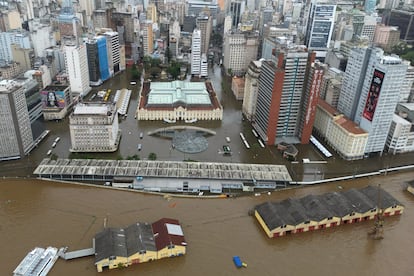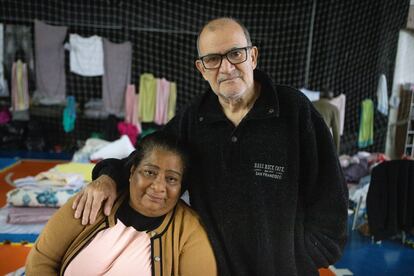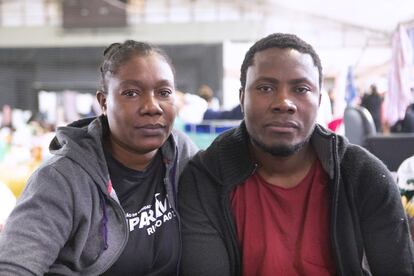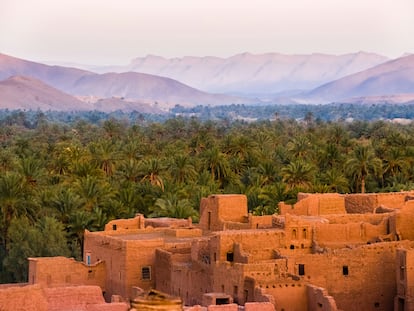How climate displacement is affecting southern Brazil
Nearly 80,000 people remain in shelters in Rio Grande do Sul. This is the story of their dramatic and uncertain situation after flooding ruined their homes and livelihoods. Meanwhile, the rains persist and the water is rising again

The dam cracked at dawn and led to chaos. Unstoppable, the water of the Gravataí River destroyed everything in its path, block by block, until it completely flooded the Sarandí neighborhood, in the northern part of the Brazilian city of Porto Alegre. When people woke up on Saturday, May 4, many of them had water up to their ankles. And Cristiane Porto did not have the strength to pull her husband and son out of the house all by herself.

“It happened very fast. We were sleeping and when we woke up, we found ourselves caught up in that confusion,” says Porto, 49, with her voice broken by pulmonary arrhythmia. Her husband, 74, suffers from Parkinson’s and in recent years has suffered two strokes that left him almost completely paralyzed. It was a phone call from her pastor in the middle of the night that alerted her to the misfortune that was coming: her house was flooding along with the entire neighborhood, and they had to get out of there as soon as possible.
With Civil Defense officials overwhelmed, two volunteers were sent by their church to try to get the family out, but the water was rising quickly and they were unable to enter. A small pond of mud, dirt, and river water had formed in the living room. Their neighbors joined the rescue effort and pulled them out, putting them in the back of a pickup truck. “We came out with water up to our waists,” says Porto.

That morning, thousands of people from the neighborhoods of the capital of Rio Grande do Sul, which has been suffering from devastating floods since the beginning of the month, had to be evacuated. The Porto family was taken to the Adventist Church of Sarandí, but they soon had to leave there as well, because the water was approaching rapidly. The dam cracked in three places. The water level reached almost 20 feet. There was no safe place in the entire neighborhood.
In the last two weeks, the Brazilian state of Rio Grande do Sul has experienced its worst climate disaster after torrential rains followed by unprecedented floods left 147 dead, 127 missing and 806 injured in at least 447 municipalities. But authorities believe these figures could increase when the water recedes. More than 500,000 people have had to leave their homes, and many do not know if they will be able to return.
In Porto Alegre, Brazil’s fifth-largest city and state capital, the Guaíba River, which surrounds part of the municipality, is still overflowing and many neighborhoods remain underwater. After receding a little, the waters have risen again due to the heavy rains this past weekend, and the local Civil Defense agency fears that the river will rise again and exceed the record set during this crisis, which already broke the previous high of 1941.

Destroyed roads, fallen bridges and completely submerged streets have blocked entrances to hundreds of cities, making it more difficult to transport humanitarian aid. Volunteers and Civil Defense agents are carrying out rescues in boats, improvised vehicles, jet skis and helicopters. Meanwhile neighbors, non-profit organizations and municipal governments have taken in almost 80,000 people evicted from their homes.
At a gym at the Serviço Social do Comércio (Sesc), in Porto Alegre, the indoor soccer field is now filled with rows of mattresses, bedsheets and hanging towels. There are 250 people sheltering there, including the Porto family.
“The flood was very bad,” says Porto sadly. “The house was flooded up to the roof, we lost everything.” It hurts her to think that this tragedy could have been avoided. She wonders why officials did not build better systems to contain the river. “They don’t do it because they just don’t want to, because they have plenty of money for it. If an institution like this had not welcomed us in, what would have become of us?” she asks.
The National Center for Monitoring and Alert of Natural Disasters (Cemadem) released a statement warning about the coming rains and the risk of urban areas being flooded in Rio Grande do Sul a week before the events that have left thousands homeless. On May 6, when the federal government declared a state of emergency in the southernmost state of the country, this organization issued a technical note reporting that, a year earlier, it was already a known fact that Porto Alegre’s infrastructure was too weak to confront disasters related to climate change.
The consensus of the scientific community is that not enough money has been invested to confront climate disasters in this state. Since his first year in office, center-right Governor Eduardo Leite has modified nearly 480 environmental regulations. The state has suffered four floods in one year.
Joarés Carvalho Alves, 73, and his wife Rita, 66, were rescued by a boat on May 1 in their Porto Alegre neighborhood of Navegantes. “The rain came suddenly. We didn’t have time to take out almost anything, or to lift the furniture [to high places]. We left with only clothes and documents.”

These pensioners had a small piece of land and a house behind Joarés’ brother’s store. Now the couple is not sure what awaits them, but they want to return home. “The house was flooded to the top. We have nothing,” he says. Rita does not look up, and her tears flow slowly as her husband tells his story.
“This had never happened to us before. Only at a time when I was not even born, in 1941, my mother told me that there was a great flood. But this one was worse, it flooded everything, the entire city,” he says.
The couple is staying in the same gym as the Portos while they wait for their son, who was rescued in another part of town and sent to another shelter, to visit them this week. “When we go back we will see the extent of the damage, what we can salvage and what we cannot. Now we’ll have to start again from scratch,” says Carvalho Alves.
Disastrous weather events have followed Asnel and Marthe Vertismat like the plague. In 2010, a strong earthquake in their native Haiti killed more than 250,000 people and left more than a million homeless. The misery and instability that followed ended up suffocating the nation, and the couple, aged 41 and 37, decided to leave Saint Michel de L’Atalaye and emigrate to Brazil in 2016 to find a better life.

The house they shared with their children, Lesly and Obed, both eight, as well as with other migrants and several Brazilians, was flooded. They were only able to rescue their documents. “We have a company there, we sew. Now everything is under water,” laments Asnel.
Mauricio Martins, a doctor who goes to the shelter every day to care for the people sheltering there, says that the situation that many are experiencing is dramatic. “They arrive here in shock. Others seem relieved,” he says. “Many people suffer from panic attacks, psychological stress. There were people worried because they had relatives whose whereabouts they didn’t know.” At the shelter, they are treated by doctors and psychologists. And thanks to donations, everyone has their basic necessities covered.
Alejandro and Rosani Ortiz, 27, also migrated to Brazil along with their three children to escape the acute economic crisis facing their country, Venezuela. Their story, like that of many Venezuelans abroad, is one of separation and displacement. They arrived in Brazil eight months ago following in the footsteps of Rosani’s mother, who settled here six years ago. After entering through the land border, they were reunited in Porto Alegre. Since then, the couple has tried to find work and prosper. Until the flood came along.

Since they live in the same building, they gathered everyone’s things in the highest apartment. “Our hopes were that it would flood [only] at the bottom and we could stay at the top. But in view of the news, that the water was rising and that we had to leave, we asked for a rescue.” Now they are waiting for the water to subside so they can return to their home. Meanwhile, they say they are grateful to be safe.
It hurts to see the situation of affected people, says Anielle, 46, who volunteers at the shelter along with her daughter Sofía, 13. “Today, anyone who is in a dry and safe place is very lucky, and the least we can do is to help.”
Sign up for our weekly newsletter to get more English-language news coverage from EL PAÍS USA Edition
Tu suscripción se está usando en otro dispositivo
¿Quieres añadir otro usuario a tu suscripción?
Si continúas leyendo en este dispositivo, no se podrá leer en el otro.
FlechaTu suscripción se está usando en otro dispositivo y solo puedes acceder a EL PAÍS desde un dispositivo a la vez.
Si quieres compartir tu cuenta, cambia tu suscripción a la modalidad Premium, así podrás añadir otro usuario. Cada uno accederá con su propia cuenta de email, lo que os permitirá personalizar vuestra experiencia en EL PAÍS.
¿Tienes una suscripción de empresa? Accede aquí para contratar más cuentas.
En el caso de no saber quién está usando tu cuenta, te recomendamos cambiar tu contraseña aquí.
Si decides continuar compartiendo tu cuenta, este mensaje se mostrará en tu dispositivo y en el de la otra persona que está usando tu cuenta de forma indefinida, afectando a tu experiencia de lectura. Puedes consultar aquí los términos y condiciones de la suscripción digital.










































